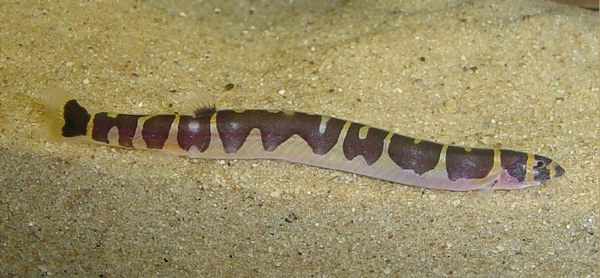Kuhli Loach
| Kuhli loach | |
|---|---|
 | |
| Kuhli loaches | |
| Scientific classification | |
| Kingdom: | Animalia |
| Phylum: | Chordata |
| Class: | Actinopterygii |
| Order: | Cypriniformes |
| Family: | Cobitidae |
| Genus: | Pangio |
| Species: | P. kuhlii |
| Binomial name | |
| Pangio kuhlii (Valenciennes in Cuvier & Valenciennes, 1846) | |
The Kuhli Loach (Pangio kuhlii) is a small eel-like freshwater fish belonging to the loach family (Cobitidae). It originates in Indonesia and the Malay Peninsula.
Contents |
Physical description
The kuhli loach is an eel-shaped fish, elongated with slightly compressed sides, and very small fins. The dorsal fin starts behind the middle of the body, and the anal fin well behind this. The eyes are covered with a transparent skin. The body has 10 to 15 dark brown to black vertical bars, and the gaps between them are salmon pink to yellow with a light underside. When the fish is not actively breeding, distinctions between males and females are not readily apparent. However, close observation will reveal that males have more a muscular upper/dorsal cross-section and their pectoral fins tend to be larger, more paddle-shaped, and often have some pigment in them. When breeding, the females often become monstrously fat and their greenish ovaries can be seen through the skin before spawning. Spawning is not easy, but when it occurs a few hundred greenish eggs are laid among the roots of floating plants. Maximum size is 4 inches (10 cm) long (matures at 2 ¾ in/7 cm), and four pairs of barbels around their mouth.
The natural habitat of the kuhli loach is the sandy beds of slow-moving rivers and clean mountain streams. They are a social fish and are typically found in small clusters (they are not schooling fish but enjoy the company of their species), but are cautious and nocturnal by nature and swim near the bottom where they feed around obstacles. They natively live in a tropical climate and prefer water with a 5.5 - 6.5 pH-but will tolerate 7.0 pH in aquaria, a water hardness of 5.0 dGH, and a temperature range of 75 - 86 °F (24 - 30 °C). Kuhli Loaches are scavengers, so they will eat anything that hits the bottom. Kuhli loaches usually feed in the night time, but can be taught to be fed in the day in the home aquarium.
Other noteworthy information
In the wild, the fish spawn communally in very shallow water. The kuhli loach is a bottom dweller that burrows into soft places. Its ordinal name 'Acanthophthalmus' comes from the meaning 'thorn' or 'prickle-eye', after a spine beneath each eye.
Etymology of name
The kuhli loach was originally described as Cobitis kuhlii by Achille Valenciennes in 1846 to commemorate Heinrich Kuhl works as naturalist and zoologist. The fish is also commonly called coolie loach, giant coolie loach, slimy loach, and leopard loach. In scientific literature, it has been referred to as Acanthophthalmus kuhlii. The genus name Acanthophthalmus is a junior synonym of Pangio.
In the aquarium
The kuhli loach is commonly kept as a pet in tropical aquaria. There are a number of species of the genus Pangio that appear similar and are sold under the same name, require similar care, and are all excellently suited for household tanks. They tend to be hardy and long-lived in the aquarium and get along well with their own kind as well as others.
In an aquarium environment, especially if the gravel is suitably finely grained, Pangio species can burrow into the bottom and there remain unseen for long periods of time, emerging to eat during the night. If the gravel is later disturbed, a hobbyist might well find themselves faced with fish assumed lost a long time ago.
There has been no documentation of Kuhli loaches breeding in aquaria.[citation needed]
See also
References
- Froese, Rainer, and Daniel Pauly, eds. (2010). "Pangio kuhlii" in FishBase. July 2010 version.
- "Pangio kuhlii". Integrated Taxonomic Information System. http://www.itis.gov/servlet/SingleRpt/SingleRpt?search_topic=TSN&search_value=640107. Retrieved 11 November 2004.
- Michael K. Oliver, ed (1977). Simon & Schuster's Guide to Freshwater and Marine Aquarium Fishes. New York, New York: Simon & Schuster, Inc.. p. 50. ISBN 0-671-22809-9.
Kuhli Loach (Pangio kuhlii)
Summary

Scientific Name: Pangio kuhlii (Valenciennes, 1846)
Common name: Kuhli Loach, Coolie Loach, Leapord Eel, Prickly Eye.
Synonyms: Acanthophthalmus kuhlii, Cobitis kuhlii
Distribution: Indonesia
Sexual Dimorphism: Females noticeably plumper when loaded with eggs like other Pangio species.
Maximum size: 4 inches
Similar to: Easily confused with other striped kuhlis.
Care: All kuhlis need well-established aquaria and should not be considered for newly set up tanks. Lots of hiding places with soft substrate. Best kept in groups, the larger the better. Three fish is the absolute minimum that should be kept together.
Feeding: Easily fed. Accepts good quality flake, sinking pellets, thawed frozen bloodworm, Mysis shrimp, brine shrimp, etc.
Water parameters: pH: 6.2-6.8. Hardness: Medium Soft to Medium. Max dh: 10
Temperature: 78 - 82ºF (25.5 - 28ºC)
Breeding: Has been bred in aquaria.

Notes
Like all Kuhlis, this species loves planted aquaria with plenty of cover and ideally with some loose leaf litter. In nature, they habitually grub around for food particles in such areas.
Kuhlis are great at getting into awkward places. Undergravel filters are less in vogue these days, but aquarists occasionally stripped down tanks that they had previously kept kuhlis in only to find a population that had obviously bred in the tank hidden beneath the undergravel plate.
Free Template Blogger collection template Hot Deals BERITA_wongANteng SEO theproperty-developer


0 comments:
Post a Comment